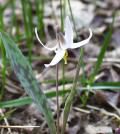

Adder’s Tongue (Erythronium americanum)
Folk Names: Adder Leaf, Adder’s Mouth, Adder’s Spears, American Adder’s Tongue, Dog-tooth Violet, Erythronium, Lamb’s Tongue, Rattlesnake Violet, Serpent’s Tongue, Snake Leaf, Trout Lily, Yellow Adder’s Tongue, Yellow Erythronium, Yellow Snake-leaf, Yellow Snowdrop
Description: The Adder’s Tongue is a perennial lily, growing from Nova Scotia to Oklahoma, Georgia, and Florida. It prefers thin woods or open areas with rich, moist soil. The ovoid corm root is 1/3 to 1 inch long, light brown outside and white and starchy inside. It is usually buried fairly deep in the soil. The plant has one to two oblong, lanceolate, pale green leaves up to 2 1/2 inches long and 1 inch wide with purplish/brownish spots. Typical of lilies, the Adder’s Tongue has a drooping, funnel-shaped flower bud which develops into a flower which is yellow or creamy white outside and yellow inside with recurving petals. The flower appears from March to May on a long stalk growing from between the leaves. Like other lilies, the Adder’s Tongue prefers to grow in colonies of its peers.
Effects: gentle, easily combined with other herbs
Planet: Moon
Element: Water
Associated Deities: none noted
Traditions:
None noted
Magic:
The Adder’s Tongue may be used in spells for lust or to combat frigidity.
Gathered during waning moon, the bulbs and leaves may be used as a plaster for tumors and boils. Soak it in cold water, wrap it in a cloth, and apply to a wound or bruise until the herb is warm, then bury wet herb in muddy place.
It is said that drinking an infusion of this herb will give you the “gift of tongues,” but refer to the medical indications below; you may only want to try this as a mouth rinse.
Known Combinations:
None noted
Medical Indications: Parts used: bulbs, leaves
An infusion of this herb may be use as an emetic.
A poultice made of Adder’s Tongue may be used on swellings and ulcers and as an emollient.
Nutrition:
The Native Americans found the bulbs edible, dried or roasted, or boiled for 20-25 minutes. The very young leaves may be boiled for 10-15 minutes and eaten with vinegar, but this is not considered a very tasty dish.
Mercantile Uses:
None noted